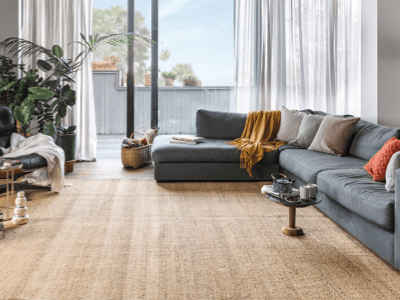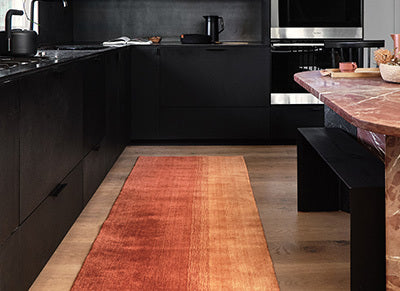














One-of-a-kind vintage rug, flatwoven in Anatolia, Turkey
Dimensions: 6'5" x 9'7" (195 cm x 293 cm)
Hjordis has been professionally cleaned; age-related wear and natural inconsistencies are inherent in these unique, handcrafted vintage rugs
Rug Type:
-
Flatweave Rugs
Reversible rugs without pile, also known as kilims, made by hand-weaving horizontal weft yarns through vertical warp yarns
Age:
-
Vintage
Typically between 20-100 years old
Main Color:
- Multicolor
- A variation of motifs—simple, tribal, bold, and colorful—all hailing from the Anatolian region (modern-day Turkey)
- Stripes—a simple and timeless classic
- The first weavers were nomadic, carrying their looms on their backs as they migrated with their flock. The resulting weaving was a narrow panel, which they’d join with other panels to create a multi-panel kilim. Each panel would vary in length, creating an occasional, charming asymmetry that will interact unexpectedly with furniture and add interest to your floor.
Anatolia makes up the majority of modern-day Turkey. Rugs from this region are defined by their tribal and geometric designs—with plenty of symbols reflecting life from traditional households.
Material DetailsWool is the most widely used fiber in Turkish rug design. Not only is it plentiful in supply, it’s durable, long-lasting, and soft—so it’s super comfy to walk and relax on. This wool pile is knotted onto a cotton foundation, another popular choice in rug design. The cotton used is rigid, strong, and provides a sturdy foundation that’s designed to last a lifetime—or ten.
- We recommend that you regularly vacuum your rug to remove dirt and grime. Depending on how heavily your rug is used, just once or twice a month is adequate. Too much vacuuming can wear down the knots and fibers more quickly. If you have a suction attachment on your vacuum cleaner, use that instead of a rotary vacuum.
- Every few months, you’ll also want to flip your rug over and vacuum the back to get the grit out of the foundation of the rug. It also helps to rotate your rug once a year to ensure even wear over time.
- Every 3-5 years, we recommend getting your rug professionally hand-washed. Please do not take it to get steam or dry cleaned—this will almost certainly damage the rug! Hand-washing requires the use of a pH-balanced shampoo, worked into the rug by hand with a soft-bristled brush, before being rinsed thoroughly. This process should be repeated a few times.
- In case of spills:
- Blot the spill until it is dry, but do not add liquid. Consult an Oriental rug specialist immediately for cleaning. Adding liquid can make it harder to remove stains, and can even extend them further. This is because moisture travels along the fiber, so in rugs with horizontal fibers (like flatweaves), it can get trapped.
Order A Sample
Hjordis - Rug Sample
Size 12" x 12"
Free shipping & return
Recently Viewed
Hjordis Vintage Kilim Rug
Buy One Rug, Get One 50% OFF with code RUGBOGO50—Hurry, BOGO sale ends 12/25! Excludes rug pads and custom rugs.
![]() Free Shipping
Free Shipping
![]() Easy Returns
Easy Returns
One-of-a-kind vintage rug, flatwoven in Anatolia, Turkey
Dimensions: 6'5" x 9'7" (195 cm x 293 cm)
Hjordis has been professionally cleaned; age-related wear and natural inconsistencies are inherent in these unique, handcrafted vintage rugs
- A variation of motifs—simple, tribal, bold, and colorful—all hailing from the Anatolian region (modern-day Turkey)
- Stripes—a simple and timeless classic
- The first weavers were nomadic, carrying their looms on their backs as they migrated with their flock. The resulting weaving was a narrow panel, which they’d join with other panels to create a multi-panel kilim. Each panel would vary in length, creating an occasional, charming asymmetry that will interact unexpectedly with furniture and add interest to your floor.
Anatolia makes up the majority of modern-day Turkey. Rugs from this region are defined by their tribal and geometric designs—with plenty of symbols reflecting life from traditional households.
Material DetailsWool is the most widely used fiber in Turkish rug design. Not only is it plentiful in supply, it’s durable, long-lasting, and soft—so it’s super comfy to walk and relax on. This wool pile is knotted onto a cotton foundation, another popular choice in rug design. The cotton used is rigid, strong, and provides a sturdy foundation that’s designed to last a lifetime—or ten.
- We recommend that you regularly vacuum your rug to remove dirt and grime. Depending on how heavily your rug is used, just once or twice a month is adequate. Too much vacuuming can wear down the knots and fibers more quickly. If you have a suction attachment on your vacuum cleaner, use that instead of a rotary vacuum.
- Every few months, you’ll also want to flip your rug over and vacuum the back to get the grit out of the foundation of the rug. It also helps to rotate your rug once a year to ensure even wear over time.
- Every 3-5 years, we recommend getting your rug professionally hand-washed. Please do not take it to get steam or dry cleaned—this will almost certainly damage the rug! Hand-washing requires the use of a pH-balanced shampoo, worked into the rug by hand with a soft-bristled brush, before being rinsed thoroughly. This process should be repeated a few times.
- In case of spills:
- Blot the spill until it is dry, but do not add liquid. Consult an Oriental rug specialist immediately for cleaning. Adding liquid can make it harder to remove stains, and can even extend them further. This is because moisture travels along the fiber, so in rugs with horizontal fibers (like flatweaves), it can get trapped.






